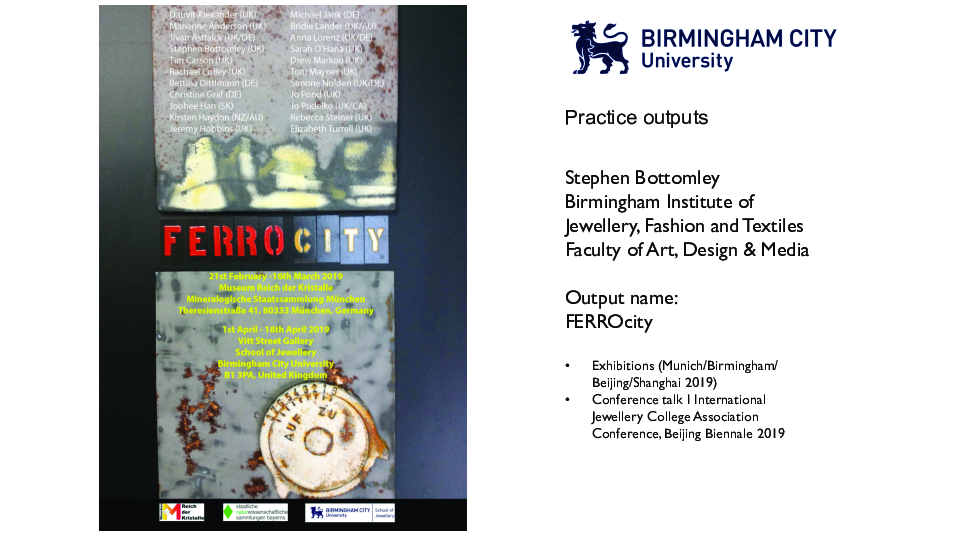Welcome to the site page for this research project.
To the right is a link to a full an illustrated justification PDF.
The Appendices links to copies of other important documentation.
FERROcity was co-curated by Stephen Bottomley and Elizabeth Turrell and exhibited the praxis of twenty-two contemporary jewellery artists who responded to one common element, iron. By interrogating iron through a creative lens, the show explored the complex process of mineral refinement embodied in jewellery materials while demonstrating the influence of iron as catalyst and fundamental element of life.
The exhibited outcomes were; 'Jewellery and objects by twenty-two contemporary makers displayed alongside gemmological samples and photography that explores the interpretation and influence of Iron as catalyst, material and fundamental element of life. The selection of contemporary metalwork and jewellery, ranging from steel vessels to recycled iron nail jewellery, presents a range of approaches to a fascinating and familiar material. The exhibition includes work by ten practicing artists and academic staff from Birmingham’s eminent School of Jewellery and ten invited international artists, as well as work by both curators. The micoscope photography has been commissioned from the school’s Gemmology department and captures the transformative effect iron has on the colouration of gemstones'.
(Press Release 2019)
The role of the exhibition, with jewellery as a focus, is central to several essays’ within the 2015 publication ‘Shows and Tales – On Jewelry Exhibition-Making’ (Lignel, editor). Contemporary Jewellery has been criticized for being presented in it's own cultural bubble and Den Besten in her essay, “The Missing Link Jewellery Presentations in the Museum”, poses the question “if the curators from other departments will see a benefit in the proposed dialogue and actually open their rooms to jewellery”. Exhibiting work within the context of a broader discipline, for example in a museum with a specific collection, was offered as a way to bridge the gap between contemporary jewellery and a wider audience.
FERROcity responded to these challenges by purposefully citing the exhibition in the permanent university museum at the Mineralogische Staatssammlung München. The gemmological science museum is helpfully and symbolically situated directly opposite the Pinakothek der Moderne which houses art, architecture and design. It is also the launch venue for opening of the annual International Jewellery Week, in which this show featured in, 13-17 March 2019.
The Mineralogische Staatssammlung and the Museum Reich der Kristalle’s crystals and gemstones had previously been a venue for the 2018 contemporary jewellery exhibition ‘Like a Rolling Stone’ (Bottomley/Cross). In the FERROcity exhibition, the museums curator at the Museum Reich der Kristalle, Dr Melanie Kaliwode was closely involved in providing objects from the museum's own archives to place alongside the contemporary jewels.
Riggs in her essay “What is it that you do exactly? Categorizing Contemporary Jewelry through Exhibitions”, makes the criticism that shows with a theme of a shared material ‘seldom let the visitors appreciate the importance of this material choice relative to a maker’s oeuvre’. The criticism that the material link is too obvious one was seen as a challenge to rise to and the choice of an element, such as iron and exploring its influence in a broader context and on often hidden levels was both subtle and complex.
The oeuvre of the artist was revealed with statements explaining the response on to iron shown with the Jewellery and objects were displayed alongside gemmological and scientific samples and electron microscope photographs that set a context for iron’s existence and influence on the world around us.
Works were subsequently exhibited in Birmingham, April 2019; then invited to the Beijing International Jewellery Biennale, October 2019; and the Shanghai Academy of International Visual Arts, November - December 2019. The researcher also delivered a paper on the same theme at the International Jewellery College Association Conference, (19.10.19).
The breadth of responses to the exhibition’s provocation underpinned the inter-disciplinary nature of jewellery as a craft and collaborative practice and originality. It was also the first international exhibition to involve staff from across all specialist subject areas in the School of Jewellery in its 130-year history, including Jewellery, Silversmithing, Horology and Gemmology.
The Beijing exhibition was significant impact as it was one of only three special exhibitions, each with their own purpose-built pavilion space. In the Beijing Biennale it was the only exhibition curated by Western scholars. The originality and scope of the work exhibited spoke to the current STEAM agenda, as a practice-based example of blending artistic creativity with scientific specialist geological and gemmological knowledge. Each individual artist response, to theme and process, was captured in an essay by US gallerist Mike Holmes published in the ‘Journal for Jewellery Research’ Volume 3, 2020.

